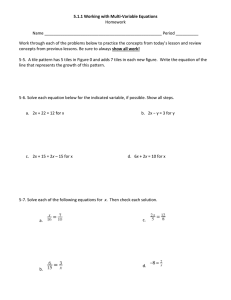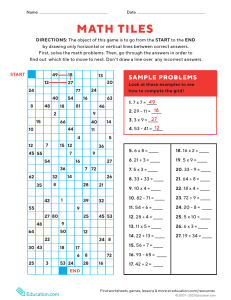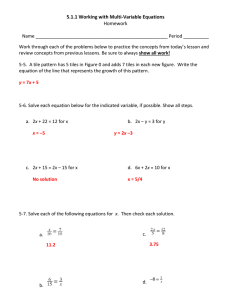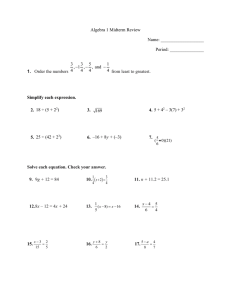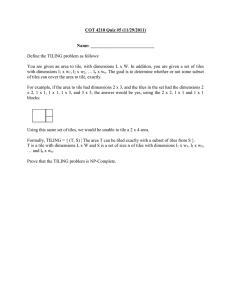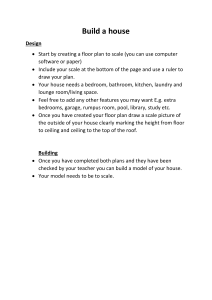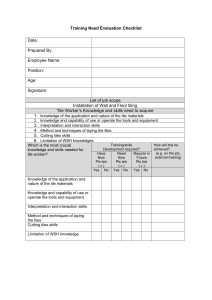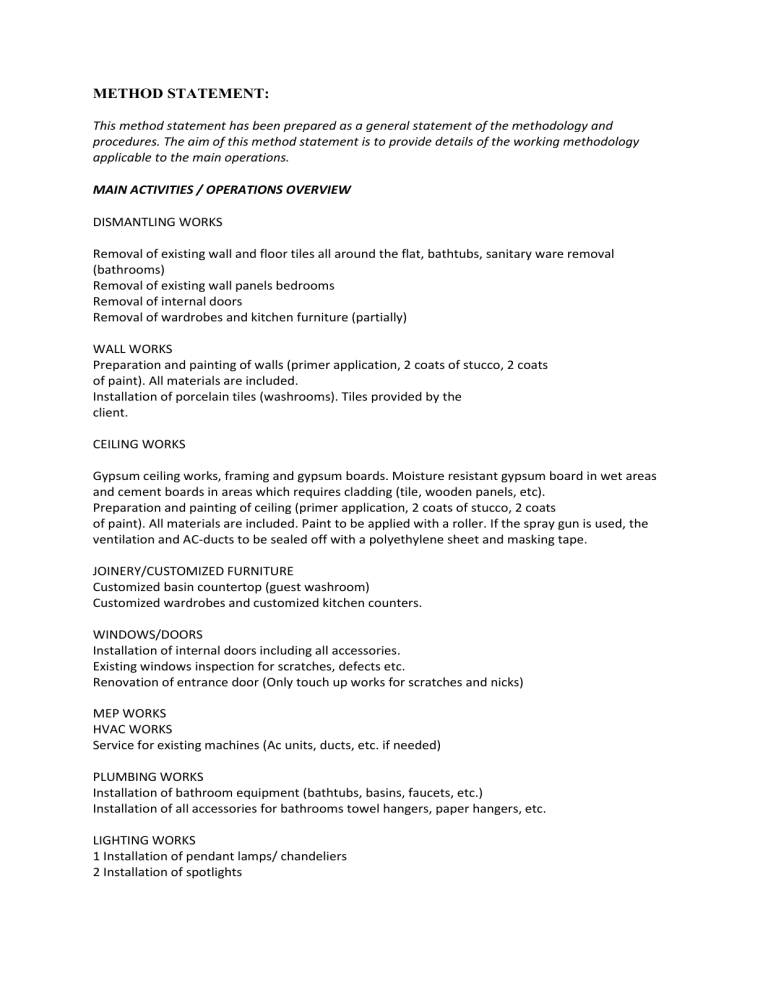
METHOD STATEMENT: This method statement has been prepared as a general statement of the methodology and procedures. The aim of this method statement is to provide details of the working methodology applicable to the main operations. MAIN ACTIVITIES / OPERATIONS OVERVIEW DISMANTLING WORKS Removal of existing wall and floor tiles all around the flat, bathtubs, sanitary ware removal (bathrooms) Removal of existing wall panels bedrooms Removal of internal doors Removal of wardrobes and kitchen furniture (partially) WALL WORKS Preparation and painting of walls (primer application, 2 coats of stucco, 2 coats of paint). All materials are included. Installation of porcelain tiles (washrooms). Tiles provided by the client. CEILING WORKS Gypsum ceiling works, framing and gypsum boards. Moisture resistant gypsum board in wet areas and cement boards in areas which requires cladding (tile, wooden panels, etc). Preparation and painting of ceiling (primer application, 2 coats of stucco, 2 coats of paint). All materials are included. Paint to be applied with a roller. If the spray gun is used, the ventilation and AC-ducts to be sealed off with a polyethylene sheet and masking tape. JOINERY/CUSTOMIZED FURNITURE Customized basin countertop (guest washroom) Customized wardrobes and customized kitchen counters. WINDOWS/DOORS Installation of internal doors including all accessories. Existing windows inspection for scratches, defects etc. Renovation of entrance door (Only touch up works for scratches and nicks) MEP WORKS HVAC WORKS Service for existing machines (Ac units, ducts, etc. if needed) PLUMBING WORKS Installation of bathroom equipment (bathtubs, basins, faucets, etc.) Installation of all accessories for bathrooms towel hangers, paper hangers, etc. LIGHTING WORKS 1 Installation of pendant lamps/ chandeliers 2 Installation of spotlights ELECRTICAL WORKS 1 Installation of sockets. Sockets provided by the client 2 Installation of switches. Switches provided by the client 3 Supply and Installation of AC thermostat. (Configurations and parameter to be same as existing one. Only the exterior design to be changed) OUTDOOR AND LANDSCAPING WORKS Removal and installation of existing tiles on the flooring. SITE CLEANING AND WEST REMOVAL Site cleaning on daily bases. All the necessary precautions to be taken to protect the main corridor outside of the flat. Dust control to be done with green mech, vacuum cleaner. Special area to be allocated for the cutting and sawing area inside the flat with adequate ventilation. Garbage removal and disposal to be done in accordance with the rules and regulations designated by Dubai Municipality. METHODOLOGY: FLOOR TILES 1. Mockup to be arranged first for approval prior to proceeding with tile works. 2. Dry and clean substrate shall be arranged for floor tiles at location mentioned in the drawings 3. All underlaying installations such as self-leveling compound, ducts, cables etc. (if any) shall be approved prior to commencement of tiling works. 4. Apply the self-leveling ready-mix compound insuring the smooth and level finishing is achieved. The overall thickness of self-leveling compound shall be a maximum of generally 10 mm or as shown in the drawings. (Weber floor smooth FD or the equivalent, 23 kg/bags). 5. Allow sufficient dryness of the underlayment material. 6. Ensure cleanness and levelness of the floor surface prior to tile works. 7. Apply cement based ready mix tile adhesive on a substrate (Webercol Pro or the equivalent). Use a notched trowel to have a uniform thickness of 2 to 3 mm minimum. The tile mortar to be applied in one direction only. 8. Apply the tiles on the substrate and back of the tiles, and press them firmly, while making sure that the paste does not slip from the tile sides and tamp it with a rubber mallet. Tiles to be applied in accordance with the approved drawing for the tile layout. 9. Apply tile joint cement based premixed non shrink grout (Weber Joint or equivalent). The color of tile grout to match the tile color. WALL TILES 1. Prior to installation of ceramic or porcelain tiles. Plaster with a rough finish to be applied in order to have a strong key for tiling work. All the MEP services must be approved prior to commencement of plastering work. 2. Tiles of specified and approved sizes shall be fixed to wall surfaces by approved adhesive/ tile glue. 3. Tamp the tile with rubber mallet to obtain required adhesion and level 4. Excessive mix/adhesive shall be maintained to plumb for the entire true level by applying uniformly pressure CEILING AND WALLS PAINT SYSTEM 1. Prepare the ceiling surface for commencement of paint system ensuring cleanliness and readiness. 2. Apply fiber mesh on the board joints and prepare it for skim coat application 3. Apply the first coat of skim coat medium with a hand trowel 4. After the first coat is dried for 24hr apply the fine coat with a hand trowel 5. Ensure levelness and evenness of the surface by sanding down the area where necessary 6. Apply the acrylic primer with a paint roller 7. Apply the first coat of paint 8. Apply the second coat of paint FLASE CEILING SYSTEM 1. Make a setting out on the ceiling and establish the location of the hanger rods 2. Fix the hanging rods with a pneumatic hammering tool 3. Assemble the U-channels and the L-channel rails. 4. 5. 6. 7. Obtain MEP-clearance for board closure Close the boards with screw. Proceed with the paint works. Works to be done in accordance with the approved site drawings. WASTE DISPOSSAL All product off-cuts, waste packaging materials including empty adhesive containers will be removed from site and disposed of to a suitable, licensed waste disposal tip. PERSONAL PROTECTIVE EQUIPMENT (PPE) Throughout all operations / activities undertaken, appropriate PPE will be worn. As a minimum this Includes protective clothing/overalls and safety footwear with toe protection. Other PPE may be Worn at the discretion of the staff on site as follows: 1. 2. 3. 4. Head protection. Gloves. Dust masks. Knee pads. When using mechanical powered equipment and certain manual tools, e.g. hammers / chisels, appropriate PPE must be worn in addition to the minimum set out above including eye protection and ear protection. TOOLS AND EQUIPMENT The tools and equipment employed in the main activities are i) hammer; ii) bolster chisel; iii) pinch bar; iv) trimming knife; v) hand saws, (wood / metal); vi) screw drivers; vii) hand scrapers, (Robert Scrapers); viii) roller / brushes; ix) sweeping brush; x) trowels; xi) miscellaneous hand tools. b) electrically operated machinery, including; i) “Bully Stripper” or “Kango with Spade”; ii) Scarifier (for paint); iii) Shot Blasting Plant; iv) Rotary brush / stone scarifier; v) Hot air guns (for ceilings and walls, plus small floor areas < 2sq metres); vi) Electric drills; vii) Electric Sanders; viii) Compressed air nail gun. c) ladders / step ladders; d) mobile access platforms. PRE-CONTRACT INSPECTION Prior to any work commencing on site the following procedure will be adopted: a) Request from client to be logged (telephone, letter or fax) b) Site meeting between Pace Contract Flooring and client to agree / identify: i) the work required; ii) the specification, range, colour; iii) when the work is required; iv) any specific hazards / risks, e.g. working in vicinity of client personnel; v) if this generic method statement is acceptable/ fully applicable or if a specific method statement should be produced; vi) are any special permits to work required, e.g. hot work permits. DRIVING ON SITE For all vehicles goods vehicles (vans). The vehicle driver will be instructed where the contract is to be undertaken by the client. When driving on client sites, any site-specific driving rules will be observed in addition to the rules applicable to travel on the public highways. Speed limits and traffic routes are to be strictly always observed. Due care and attention is to be paid to parking, avoiding the blocking of emergency / fire escape routes and established walkways etc. Particular attention is to be afforded to the issue of waste and all loads in vehicles are to be adequately secure whilst in transit. ARRIVAL AT CONTRACT SITE / DESIGNATED WORK AREA Upon arrival at the contract site, the following procedure will be followed: a) Briefly survey the working area, ensure suitable to work. Any potential problems to be reported to the client representative immediately requesting appropriate action to be taken prior to starting work. b) Position hazard identification tapes and warning signs to effectively isolate the working area. c) Head Protection to be worn (if necessary); d) Care should be taken not to obstruct any established walkways or emergency escape routes. NOISE CONCERNS Any noisy works to be executed in accordance with the permissible working hours stated by the building management stated in the final permit or correspondence letter. HANDLING OF EQUIPMENT / MATERIALS All equipment / materials will be transported to site unless a direct delivery arrangement has been arranged with a supplier. If materials are to be stored temporarily on site, care should be taken as to the any potential fire hazard / physical obstruction presented. Clarity should be sought from the client / fire safety officer prior to temporarily storing any materials on site. Subject to permission, materials / equipment should be neatly stacked not to cause blockage of pass ways and corridors. HAND OVER PROCEDURES Upon completion of the installation of the new floor / ceiling / wall covering, the “job” / work area will be formally handed back to the client. This could be in the form of a verbal confirmation from Pace Contract Flooring or a more formal (written) Hand over if required.
